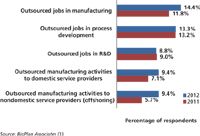Gauging Biopharm Outsourcing
Budgets for biopharmaceutical activities are gaining in select functional areas except outsourcing.
Planning and decision-making for the manufacture of biopharmaceuticals are becoming more complex as companies continue to implement cost-saving efforts, including outsourcing many support and even critical tasks. Companies must make difficult strategic decisions about commercial manufacture earlier in product development. A recent BioPlan Associates analysis found that essentially all biopharmaceutical developers use outsourcing services of some kind for the manufacture of clinical or commercial supplies, process development, R&D, assay services, fill–finish, or other activities (1).

Eric Langer
Cost-cutting not a factor
The BioPlan survey, which included responses from 302 representatives from biopharmaceutical companies and CMOs in 29 countries, evaluated 23 key outsourcing areas in biomanufacturing (1). The study showed that companies are incorporating outsourcing as a manufacturing strategy rather than as an ad hoc method of adding flexible capacity or to simply eliminate overhead costs associated with lower value production activities. Data also show a spike in the percentage of biopharmaceutical companies projecting outsourcing of analytical testing, validation services, and fill–finish activities.
The BioPlan study further evaluated how companies are addressing cost issues in biopharmaceutical manufacturing. The survey identified activities biomanufacturers undertake to reduce costs. The study showed that outsourcing activities ranked in the bottom quarter of measured factors to reduce costs although outsourcing increased slightly for certain functions as a strategy for cost-containment during the past 12 months (see Figure 1). There was an increase in respondents using outsourcing of jobs in manufacturing to cut costs: 14.5% in 2012, up from 11.8% in 2011. Approximately 13% of respondents outsourced jobs in process development and 8.8% did in R&D. An equal number of respondents (9.4%) reported outsourcing manufacturing activities to domestic and nondomestic service providers. (see Figure 1).

Figure 1: Outsourcing actions taken by biomanufacturers to reduce costs at facilities during the past 12 months. (ALL FIGURES ARE COURTESY OF THE AUTHOR)
Outsourcing budgets flat
The survey showed clear evidence that budgets are bouncing back in all areas in 2012, except outsourced manufacturing. The uptick in areas other than outsourcing represents a change from two years ago when budgets decreased in areas ranging from production, hiring new scientific staff, and new facility construction.
The survey also separately asked respondents to indicate how their outsourcing in R&D and manufacturing will change during the next 12 months. On average, future outsourcing at individual facilities will see moderate overall increases for all types of outsourcing not just manufacturing (9.3% during the next 12 months). These increases are more heavily distributed on key outsourcing areas (see Figure 2) rather than broadly seen as increases across all operations.

Figure 2: Select outsourcing activities projected to be done at significantly higher levels.
Projections
The survey evaluated 24 different areas associated with outsourced operations and asked respondents which activities will be outsourced "more often" during the next 24 months. More than one-third (35.4%) expect to increase outsourcing of analytical testing/bioassays. BioPlan believes much of this increase relates to product characterization, including for biosimilars.
Validation services was the area where respondents predicted the highest rate of increase (32.3% indicated high rates in outsourcing in 2012, compared with 22.1% in 2011 and 23.8% in 2010). Also, 26.2% of biomanufacturers predict they will outsource significantly more fill–finish operations during the next 24 months compared with 23% in 2011, and 25% in 2010. Other areas of outsourcing growth include: API biologics manufacturing,cell-line development, testing for lot release,and toxicity testing. Some recent decreases in predictions for outsourcing growth are in: downstream production operations, testing/product characterization, media optimization; upstream production operations, regulatory services, upstream process development; and testing cell-line stability.
Looking ahead
The biopharmaceutical industry continues to focus on productivity, efficiency, getting more out of existing internal resources, and maximizing performance from their provider relationships. Although outsourcing can improve overall efficiency and reduce costs, the management of relationships continues to be challenging and necessitates CMO/CRO flexibility to meet clients' shifting needs. Data from this study shows that CMOs are expanding their manufacturing competence through the use of novel technologies, single-use/disposable bioreactors, and other differentiated bioprocessing services. Improved services are resulting in increased adaptability, lower costs, faster turnaround, and higher yields, thereby offering more choice for biopharmaceutical companies. At the same time, the costs for using CMOs for product manufacturing are becoming slightly more competitive.
Eric Langer is president of BioPlan Associates, tel. 301.921.5979, elanger@bioplanassociates.com, and a periodic contributor to Outsourcing Outlook.
Reference
1. BioPlan Associates, 9th Annual Report and Survey of Biopharmaceutical Manufacturers (Rockville, MD, April 2012), www.bioplanassociates.com.

Drug Solutions Podcast: A Closer Look at mRNA in Oncology and Vaccines
April 30th 2024In this episode fo the Drug Solutions Podcast, etherna’s vice-president of Technology and Innovation, Stefaan De Koker, discusses the merits and challenges of using mRNA as the foundation for therapeutics in oncology as well as for vaccines.